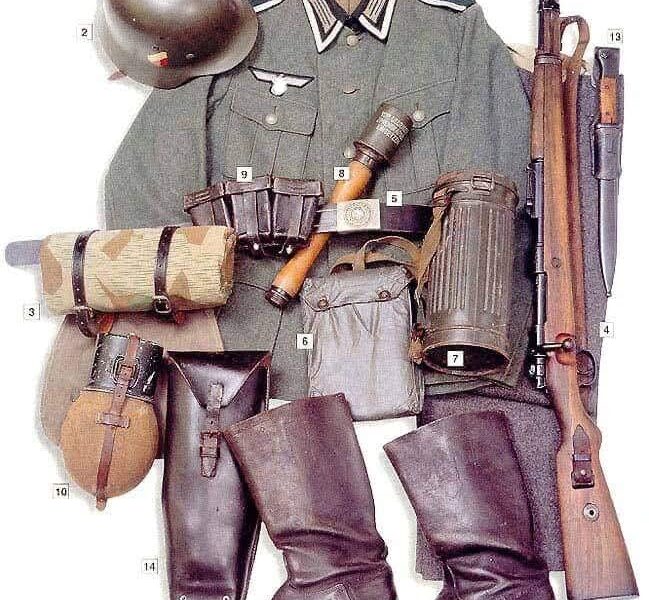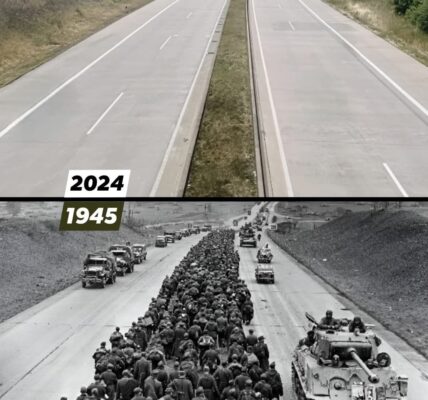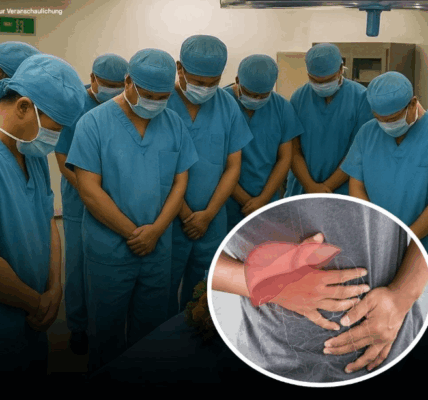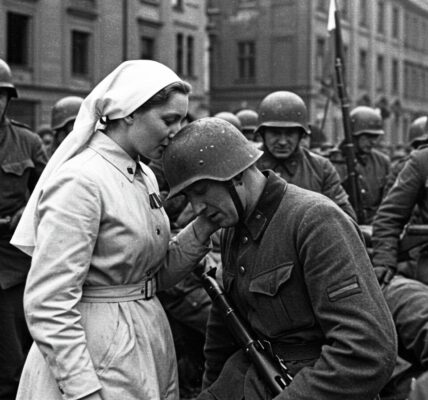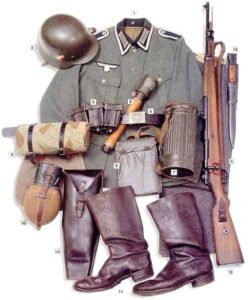
1. Field Blouse Model 1935 with NCO Insignia
This classic wool field blouse, known as the M-35, was the standard uniform of the Wehrmacht. The blouse features the typical epaulettes and collar patches of a non-commissioned officer and embodies the distinctive appearance of a German non-commissioned officer at the beginning of World War II.
2. Model 1935 Steel Helmet
The famous M-35 steel helmet, with its aerodynamic shape, offered the wearer improved protection over older models. It was made of high-quality steel and often featured insignia or camouflage patterns.
3. Model 1931 tent tarpaulin in splinter camouflage pattern.
This multifunctional tent tarpaulin served not only as shelter, but could also be used as a rain cape or camouflage. The “splinter pattern” was one of the Wehrmacht’s first standardized camouflage patterns.
4. Field Trousers
Made of sturdy wool, field trousers were part of the standard uniform. They offered great freedom of movement and contributed significantly to the typical appearance of the German soldier.
5. Leather Belt with Buckle:
A sturdy leather belt to which various items of equipment could be attached. The metal buckle was often decorated with the Wehrmacht eagle and the inscription “Gott mit uns” (God with us).
6. Gas Tarpaulin in Ochre Yellow
. Part of the standard gas protection equipment. This tarpaulin protected the soldier’s body from chemical warfare agents and could also be used as an emergency poncho.
7. Model 1938 Gas Mask with Carrying Case.
The M-38 was an improved version of the gas mask with a better fit and visibility. It was carried in a cylindrical metal container that provided both protection and storage.
8. Model 1924 Stielhandgranate (“Potato Masher”)
This iconic German hand grenade was known for its effectiveness and ease of use. The wooden handle made it easy to throw over long distances.
9. Leather ammunition pouches.
These sturdy pouches offered space for several cartridge clips and were attached directly to the belt. They were essential for a quick ammunition supply in combat.
10. Model 1931 Aluminum Canteen.
A compact, felt-covered canteen worn on a belt with a leather strap. A fundamental piece of equipment for every soldier in the field.
11. Leather marching boots (“Knobelbecher”)
These high leather boots were known for their durability and robustness. They enabled long marches over a wide variety of terrain.
12. Karabiner 98k – 7.92 mm Mauser Rifle
The standard rifle of the German infantry – precise, reliable, and powerful. The Karabiner 98k was valued for its accuracy and robust construction.
13. Bayonet 84/98 – Bayonet
The bayonet served both as a close-combat weapon and as a tool. It could be attached to the carbine and was an integral part of the equipment.
14. Wire cutters (barbed wire cutters)
Indispensable for negotiating barbed wire entanglements. These sturdy wire cutters were often part of the engineer’s equipment or carried by assault troops.
